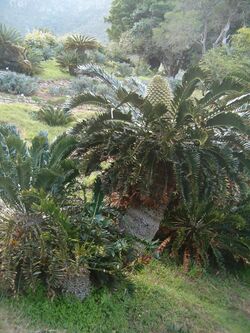Biology:Encephalartos latifrons
| Encephalartos latifrons | |
|---|---|

| |
| Encephalartos latifrons at Kirstenbosch National Botanical Garden | |
| Scientific classification | |
| Kingdom: | Plantae |
| Clade: | Tracheophytes |
| Clade: | Gymnospermae |
| Division: | Cycadophyta |
| Class: | Cycadopsida |
| Order: | Cycadales |
| Family: | Zamiaceae |
| Genus: | Encephalartos |
| Species: | E. latifrons
|
| Binomial name | |
| Encephalartos latifrons Lehm.
| |
| <mapframe height="200" frameless="1" width="300">{"properties":{"stroke-width":6,"stroke":"#ff0000","title":"Encephalartos latifrons"},"type":"ExternalData","title":"Albany Cycad range.map","service":"page"}</mapframe> | |
| Albany Cycad (Encephalartos latifrons) distribution | |
Encephalartos latifrons (known as the Albany Cycad) is a species of cycad that is native to Eastern Cape province in South Africa at elevations of 200 and 600 metres.[3]
Description
This is a tall, tree-like cycad plant with a stem that can be upright or lying down, reaching up to 4.5 meters in height and 30-45 centimeters in diameter. Its bright green, feather-like leaves grow in a cluster at the top of the trunk, each leaf being 1-1.5 meters long and supported by a 10-20 centimeter long stalk that curves downward. The leaves are made up of many pairs of large, leathery leaflets, each up to 15 centimeters long, arranged at a sharp angle along the central leaf spine, partially overlapping, and with the lower edges having 3-4 triangular lobes. This plant is dioecious, meaning it has separate male and female specimens. Male plants have 1-3 short, cylindrical cones that are about 30-50 centimeters long and 8-17 centimeters wide, olive-green in color. Female plants have 1-3 upright, cylindrical cones that are about 50-60 centimeters long and 23-25 centimeters wide, also olive green, with macrosporophylls about 8 centimeters long. The seeds are roughly egg-shaped, 2.5-3.0 centimeters long, and covered with dark red sarcotesta.[4]
Habitat and Distribution
E. latifrons occurs (or, more correctly, used to occur) in scattered groups in the districts of Bathurst and Albany in the Eastern Cape province. The plants grow on rocky outcrops and hill slopes, usually amongst scrub bush vegetation. The rainfall ranges from 1000mm to 1250mm per year, on average, and is fairly evenly distributed during the year. Frost does not occur. Summers may be hot and fairly dry. There existed an early report of E. latifrons occurring in the Uitenhage district, but this was almost certainly a mistake, possibly as a result of incorrect labelling.[5]
Conservation
In August 2014 thirteen Encephalartos latifrons cycads were stolen from Kirstenbosch Botanical Gardens in Cape Town, South Africa. The estimated value of all thirteen was at least R200,000 (US18,675). The plants were planted over 100 years ago as part of a research and reproduction programme of this particular species of Encephalartos that no longer naturally reproduces in the wild. Encephalartos is highly valued as a garden or ornamental plant in many parts of the world and it is thought the plants were stolen to be sold on the black market.[6]
Threats
Encephalartos latifrons, a plant species, now exists in areas used for pineapple and chicory farming and livestock rearing. Historical photos indicate the disappearance of plants at several sites by 1996, possibly due to land use changes. The primary threat to the species is the trade in cycads, driven by its rarity. The removal of mature plants is a significant risk, as the species heavily relies on adult survival, and the extinction of natural pollinators and a lack of recent seed production add to its challenges.[7]
References
- ↑ Donaldson, J.S. (2010). "Encephalartos latifrons". IUCN Red List of Threatened Species 2010: e.T41892A10571584. doi:10.2305/IUCN.UK.2010-3.RLTS.T41892A10571584.en. https://www.iucnredlist.org/species/41892/10571584. Retrieved 12 November 2021.
- ↑ "Appendices | CITES". https://cites.org/eng/app/appendices.php.
- ↑ "Encephalartos latifrons in Tropicos". http://www.tropicos.org/Name/9600071.
- ↑ "Encephalartos latifrons". 2016-01-04. https://pza.sanbi.org/encephalartos-latifrons.
- ↑ "Cycad Society SA: Encephalartos latifrons". 2008-05-09. http://www.cycadsociety.org/latifrons/latifrons.html.
- ↑ Yeld, John (5 August 2014). "Endangered cycads stolen from Kirstenbosch". Cape Argus. http://www.iol.co.za/news/crime-courts/endangered-cycads-stolen-from-kirstenbosch-1.1730495#.U_TAFfmSx8E. Retrieved 21 August 2014.
- ↑ "Redlist article about the Encephalartos latifrons". https://www.iucnredlist.org/species/41892/51052295.
External links
Wikidata ☰ Q3724980 entry
 |


